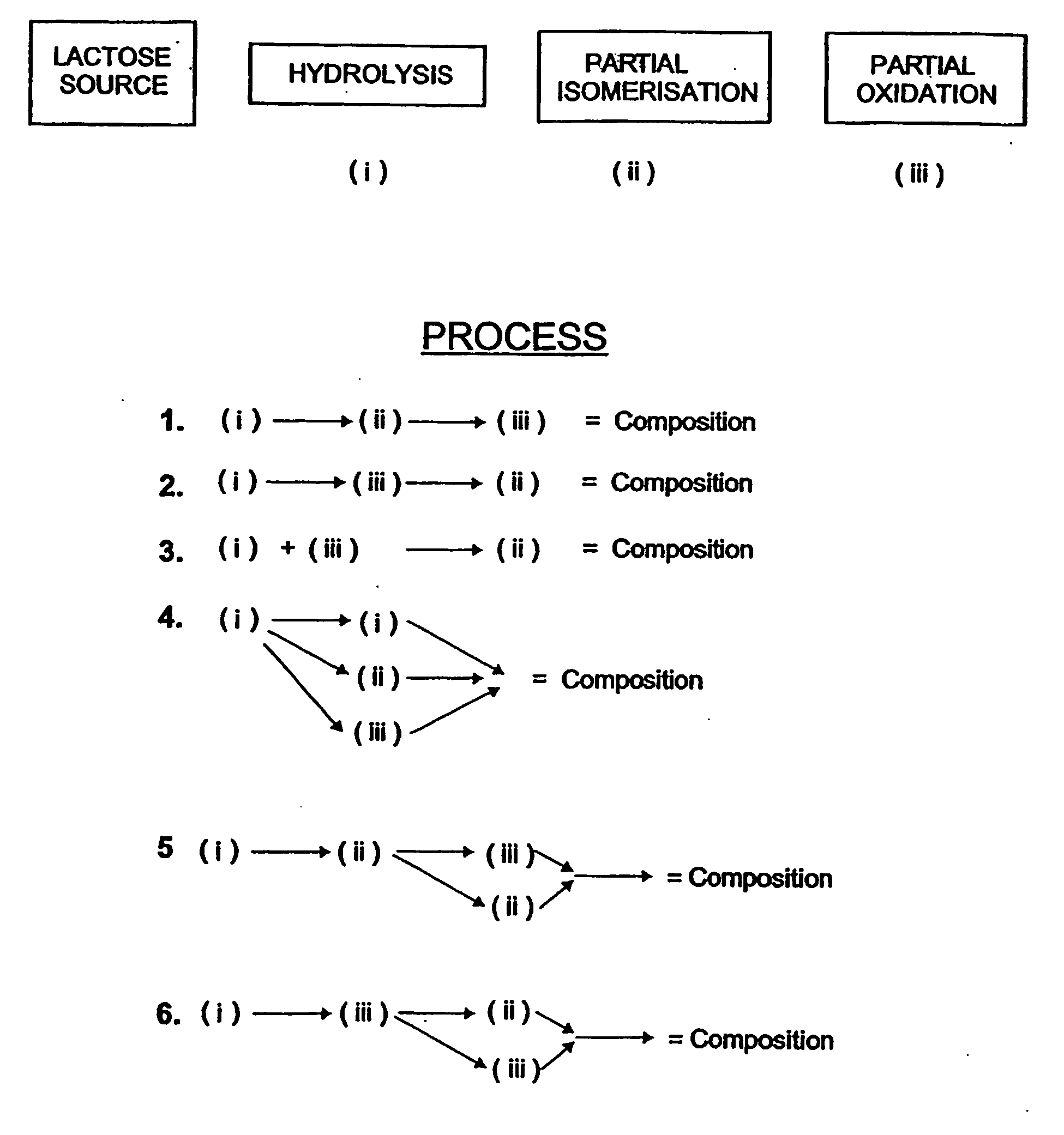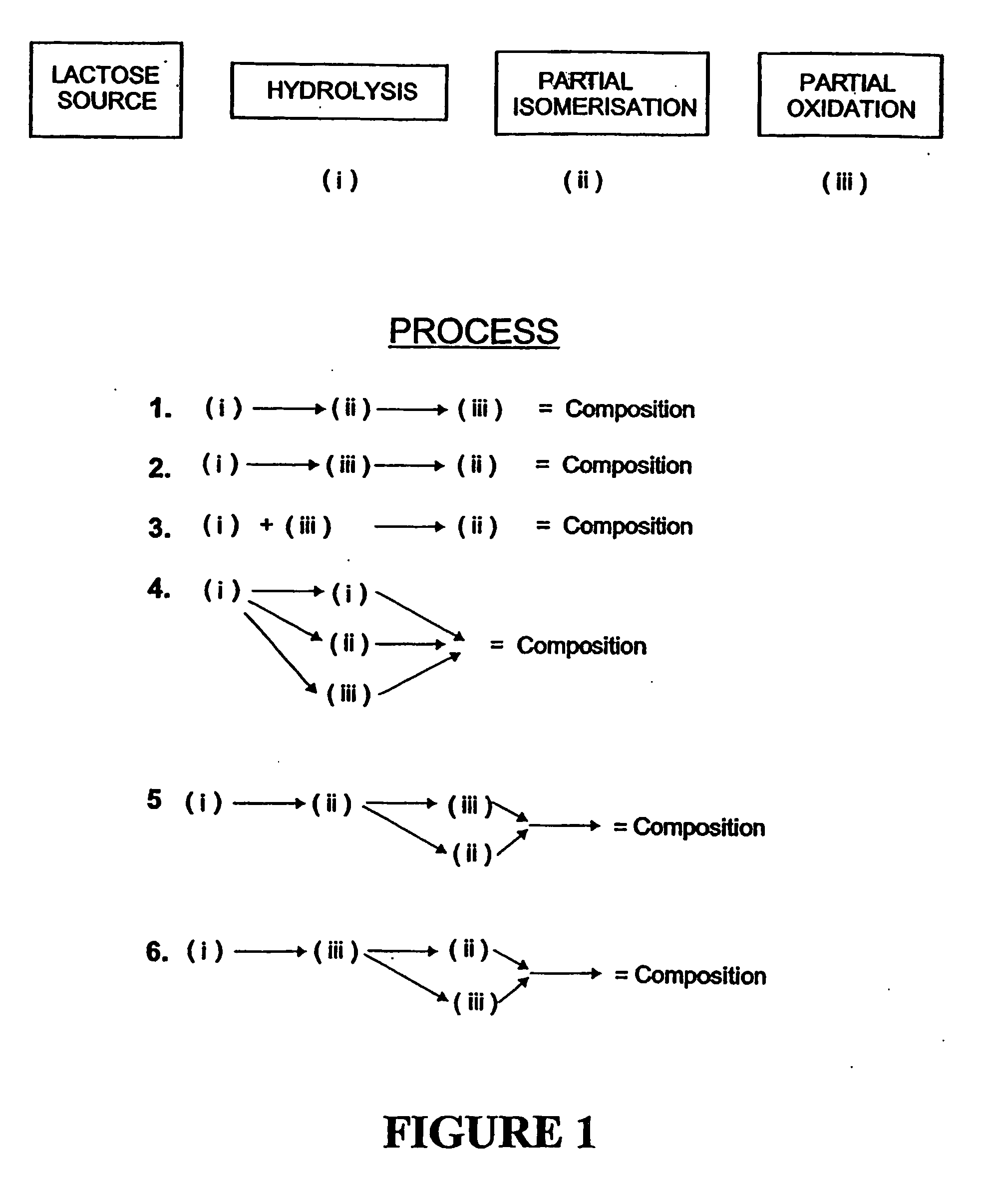Process for producing a carbohydrate composition
a technology of carbohydrate composition and process, which is applied in the direction of sugar derivates, sweetmeats, food preparation, etc., can solve the problems of variability of end composition, high cost of hydrolysis, and high cost of sugar in pure form
- Summary
- Abstract
- Description
- Claims
- Application Information
AI Technical Summary
Benefits of technology
Problems solved by technology
Method used
Image
Examples
example 1
[0077] Lactose monohydrate (BDH, 45 g) was dissolved in 255 g tap water. The pH of the solution was adjusted to pH 5 with citric acid. The flask was heated to 50° C. in a waterbath, and lactase (0.90 g of Enzidase Fungal Lactase 50,000 available from Zymus International, New Zealand) was stirred in. Hydrolysis was allowed to proceed at 50° C. for 24 hours. The solution was then cooled, and analysed for glucose. The glucose concentration was 7.1%.
[0078] The solution was then divided into 2 portions, A, 200 g and B, 100 g. Calcium carbonate (1.94 g) and glucose oxidase (Fermizyme 1500, 0.1 g) and catalase (Catazyme 25L, 0.1 g) were added to portion B in a flask and the flask vigorously shaken by a mechanical shaker in a water bath at 50° C. for 4 hours.
[0079] Portion A was placed in a flask and heated to 60° C. Glucose isomerase (Sweetzyme IT, 2 g) was added and kept in suspension by gentle shaking in a shaking incubator at 60° C. After 2 hours the Sweetzyme was allowed to sediment,...
example 2
[0081] Milk permeate was obtained by ultrafiltration of skim milk and had the composition: 4.6% lactose, 0.47% ash, pH 6.5. Permeate (1 kg) was placed in a flask and adjusted to pH 7.2 with magnesium carbonate (0.1 g). The flask was heated to 40° C. in a water bath and gently stirred. Lactase (Maxilact L2000, 1.25 g) was added and incubated at 40° C. for 4 hours. The pH of the permeate was measured at intervals and maintained at 7.4 to 7.2 by additions of 1M HCl (1.25 mL total). After 4 hours an aliquot of the permeate was withdrawn for glucose analysis. The glucose content was 2.0%.
[0082] The permeate was then heated to 55° C. and vigorously aerated with a stream of air. Glucose oxidase (Fermizyme GO 4000 L, 0.1 mL) and catalase (Catazyme 25L, 1.0 mL) were added and the pH monitored. When the pH reached 4.5, magnesium carbonate was added to raise the pH to 5.2. The pH was then kept between 4.5 and 5.2 by continuous monitoring of the pH and additions of magnesium carbonate, until 3...
example 3
[0085] Lactose hydrate (BDH, 50 g) was dissolved in milk permeate (1 kg) obtained by ultrafiltration of whole milk and comprising 4.6% lactose, 0.47% ash. The pH of the solution was raised to 8.0 by the addition of dipotassium hydrogen phosphate (32 g). The solution was heated to 50° C. and held at this temperature for 15 minutes. It was then cooled and centrifuged.
[0086] The supernatant was adjusted to pH 7.2, and lactase (Lactozyme 3000L, 2.5 g) was added. The temperature was raised to 45° C. and hydrolysis allowed to proceed for 6 hours. The solution was analysed for glucose. The glucose concentration was 5.13%.
[0087] The temperature was then raised to 60° C., magnesium chloride hexahydrate (0.5 g) and glucose isomerase (Sweetzyme IT, 10 g) were added and kept in suspension by gentle stirring with an overhead stirrer, Incubation was continued for 2.5 hours, and then the solution was cooled, and the Sweetzyme allowed to settle. The supernatant solution was decanted from the sett...
PUM
| Property | Measurement | Unit |
|---|---|---|
| temperatures | aaaaa | aaaaa |
| temperatures | aaaaa | aaaaa |
| temperature | aaaaa | aaaaa |
Abstract
Description
Claims
Application Information
 Login to View More
Login to View More - R&D
- Intellectual Property
- Life Sciences
- Materials
- Tech Scout
- Unparalleled Data Quality
- Higher Quality Content
- 60% Fewer Hallucinations
Browse by: Latest US Patents, China's latest patents, Technical Efficacy Thesaurus, Application Domain, Technology Topic, Popular Technical Reports.
© 2025 PatSnap. All rights reserved.Legal|Privacy policy|Modern Slavery Act Transparency Statement|Sitemap|About US| Contact US: help@patsnap.com


